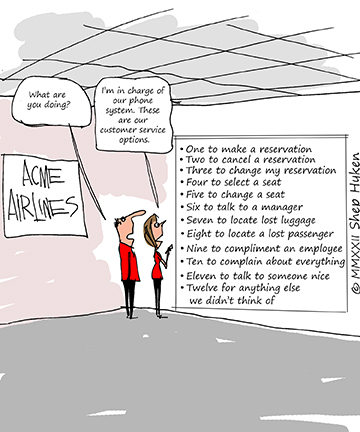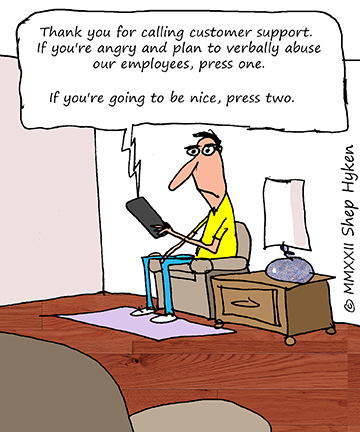Shep Hyken's Blog, page 59
August 15, 2022
5 Top Customer Service Articles of the Week 8-15-2022
Each week I read many customer service and customer experience articles from various resources. Here are my top five picks from last week. I have added my comment about each article and would like to hear what you think too.
We Listen to Our Customers. Really? by Melissa Henley(CMSWire) Listening doesn’t just matter in your personal relationships — it’s vital to your professional ones, too. We’ve all heard the stat that 84% of companies that focus on the customer experience see a corresponding jump in revenue. For customers, trusting that their feedback is being heard and that it matters is vital to building a longstanding, trusting relationship. It helps build eVoicngagement, nurture advocates, and, most importantly, build brand fidelity.
My Comment: Feedback is a gift, so accept it with open arms. There’s a great line in the article: “Getting feedback isn’t the end of the process – it’s just the beginning.” I’ve seen companies do a great job of collecting feedback, and then nothing happens after that. Why ask the customer to spend time giving you feedback if you don’t plan to do anything with it? (Rhetorical question!)
Post-Purchase Marketing Strategy: 8 Tips on How to Stay in Touch With Customers And Boost CX by Jenna Bunnell(RIS News) How do you make the most of post-purchase marketing, helping to retain customers and create a sense of loyalty to your brand? It doesn’t have to be difficult and it’s likely your business already uses post-purchase marketing strategies. Instead, it’s a matter of using these in line with your customer service objective and continuing to show interest in your customers. Here are eight tips for the post-purchase customer experience.
My Comment: It’s been said that the most abused customer is a sold customer. In other words, the effort made to get the customer to buy is substantially higher than after the purchase. Sometimes, once a customer buys, the company and its salespeople seem to disappear – until the customer decides to buy again. Here’s a great article with “post-purchase” marketing strategies to keep in touch with existing customers.
4 Ways To Prioritize Customers In Difficult Times by Serenity Gibbons(Forbes) Despite these realities, you have a business to run. And you can’t run it without a constant stream of customers. Yet it’s safe to say that your customers need something different from you now than they did even a year ago. They need your concern, your care, and your creativity in helping them get through their challenges. As a reward, you’ll be more apt to receive their loyalty in return, which will help you overcome your company’s own economic-related struggles.
My Comment: In difficult times, such as the economy, COVID, etc., it’s important to focus on the customer’s success with whatever you sell. Tough times allow you an opportunity to be a partner, not just a vendor, with your customers. Showing customers a little more love during trying times can go a long way to building loyalty.
Top Customer Survey Questions for Valuable Feedback by The InMoment Team(InMoment) How do you respond when someone asks, “Are you doing okay today?” What if someone asked, “How do you feel today?” Most likely, you would answer these two questions slightly differently. One question asks you just generally how you feel while the other implies that you might not be doing well in the first place, so you might answer differently. There was bias in the wording of one question while the other stayed more open-ended.
My Comment: If you’ve ever struggled to come up with great questions to ask on a customer survey, this article may be exactly what you’re looking for. It looks at four types of questions – open-ended questions, yes/no questions, options questions, and scale questions. In addition, the article covers survey formats.
In Times of Economic Uncertainty, Invest in CX Technologies by Robin Gareiss(No Jitter) Going by the classic definition of a recession— two consecutive quarters of negative GDP growth — the U.S. is now in a recession. Recessions typically necessitate a re-evaluation of spending and growth plans, and in years past, it meant a reduction in spending on technologies to address customer experience (CX).
My Comment: When and why should you invest in CX technologies? The why is obvious. Because that’s been a main decision-making driver for the customer. Our customer service research confirms that focusing on CX is a priority. But when to make the investment? It’s not too late, and according to this article, especially during times of economic uncertainty. Want to know why? Read the article to find out!
[image error]Shep Hyken is a customer service expert, professional speaker, and New York Times bestselling business author. Go to The Customer Focus to learn more about our customer service training programs. Follow on Twitter: @Hyken
to learn more about our customer service training programs. Follow on Twitter: @Hyken
The post 5 Top Customer Service Articles of the Week 8-15-2022 appeared first on Shep Hyken.
August 12, 2022
Guest Post: How To Reduce Customer Support Tickets And Enhance CX?
This week we feature an article by Soumya Juttukonda, a content developer & digital media strategist at Knowmax, an AI enterprise knowledge base solution to enhance customer service. She shares how you can reduce customer support tickets and enhance customer experience.
The last thing you want in your business is to face an increased number of customer support tickets.
As your team receives more customer service tickets, it will put a strain on the existing resources, leaving employees frustrated, that may end in a poor customer experience. It is in the interest of any business to reduce customer support tickets and improve customer experience. According to a survey, around 52% of customers are willing to pay more for a better customer experience.
As the average number of customer tickets is one of the parameters that businesses track to judge the level of performance of customer service, it is important to focus on reducing customer support tickets and improving customer experience.
Here is how you can reduce customer support tickets and enhance CX:
1 .Map the customer journeyIt is important to map the customer journey and identify the possible customer touchpoints. This will help to match it with the core metrics of the business to figure out the opportunities and challenges for a business to provide a better customer experience.
Customer journey mapping would help you to identify the processes, needs, and customer perceptions as they continue to engage at different stages of the journey.
2 . Create self-service solutionsOne of the best ways you can reduce customer service tickets and improve CX is by creating customer self-service solutions. As an increasing number of customers would raise customer service tickets, it would result in a longer wait time for the customer. The longer wait times would result in poor customer experience and will impact brand reputation as well.
By creating self-service solutions like FAQs and other knowledge-based solutions, you can expect the customer to find solutions for commonly faced issues on their own, while the customer support team can focus on more serious queries that need human intervention.
3 . Embrace omnichannel experienceYou can no longer expect the customer to log into a desktop and get on your website to fill out the contact form to get in touch with the support team via email or wait for a long time to speak to a customer service agent.
Customers expect brands to provide an omnichannel experience. An omnichannel experience can be built by being available where the customer is spending time rather than expecting them to come to you. It can be on social media, public forums, mobile applications, or any other platform that the customer uses. A brand needs to embrace an omnichannel presence and provide a consistent experience across all platforms.
4 . Prioritize support ticketsYou can prioritize support tickets based on the urgency of the issue. For instance, in the banking industry, cases on the lines of fraud and other similar instances should be dealt with on high priority, while other customer issues can be resolved by self-service or in-person channels depending on the nature of the issue.
By opting to prioritize support tickets, you would be able to provide a better customer experience by resolving important queries first.
5 . Merge support ticketsAnother important way with which you can reduce customer support tickets is by merging support tickets. As customers feel impatient or frustrated because of the time being taken to resolve the issue they are facing, you can end up with more than just one ticket from the same customer.
It is a good practice to merge the support tickets into one. This will help you to reduce the number of customer support tickets being raised and provide better data to your support team to resolve the issue at hand.
6 . Develop decision treesAnother route that can help you to reduce customer support tickets is the creation of troubleshooting trees via a decision tree maker. This information will help your customer support team to conclude a set procedure. These decision trees can also be useful in developing self-service solution tools. As they can provide a guided roadmap to the resolution of customer queries, decision trees help improve customer experience with consistency and faster resolution to queries.
7 . Follow a proactive approachYou need to have a proactive approach if you want to reduce customer support tickets. It is important to identify all the possible challenges that a customer may face while using the product or service and provide answers to the customer queries on self-service channels, social media, websites, and other platforms that are being used by the customer. By following a proactive approach, you would not want the number of customer support tickets to blow out of proportion on a particular issue before answers are provided on relevant platforms. These answers would be available in the first instance as the customer faces any issue.
8 . Opt for technological solutionsIn the era of technology, you should opt for solutions that help you provide a better customer experience. These solutions can focus on knowledge base management system, visual guides, chatbot creation, or visual assistance. Depending on the issues that your business is facing, you can deploy solutions to help you provide service to the customer. With a solution that helps you provide better CX, you can expect the customer support tickets to go down.
To sum upThese are some of the steps that can help you improve customer experience and reduce the number of customer service tickets that are being raised. One of the first few steps in this journey can be to opt for a knowledge management platform like Knowmax. The AI-powered can help you in a variety of ways to reduce customer support tickets, including creating visual guides, decision trees, self-service solutions, and making chatbots smarter and more efficient. With Knowmax on your side, you can expect the customer support tickets to go down and CX scores to go up.
Sowmya Juttukonda is a content developer & digital media strategist at Knowmax, a knowledge management system to enhance customer service.
 For more articles from Shep Hyken and his guest contributors go to customerserviceblog.com.
For more articles from Shep Hyken and his guest contributors go to customerserviceblog.com.
Read Shep’s latest Forbes article: Creating An Amazing Customer Experience On A Budget
The post Guest Post: How To Reduce Customer Support Tickets And Enhance CX? appeared first on Shep Hyken.
August 10, 2022
Press One to Do This, Two to Do That … Phone Tree Abuse!
 We’ve all experienced it. We’ve called the customer support line, and a pre-recorded message answers stating, “Press one for this, two for that, etc., etc. Well, it happened to me again – the third time this week – and this is how it went down.
We’ve all experienced it. We’ve called the customer support line, and a pre-recorded message answers stating, “Press one for this, two for that, etc., etc. Well, it happened to me again – the third time this week – and this is how it went down.
I listened to the prompts. I was at number four, thinking this one might be it, but I wasn’t 100% sure, so I kept listening. I got to number six when the recording said that I could listen to the options again. I did, and even then, I wasn’t sure which option to choose. I tried pushing “0,” and nothing happened, so I chose number four, thinking that it was the closest to what I needed.
That turned into a seven-minute wait. In all fairness to the company, there was a recording that informed me of how long the wait would be. I multi-tasked while waiting for the customer service rep to join the conversation. Once the rep came on the line, I conveyed my issue. She politely informed me that I had pressed the wrong option. I should have pressed number three, and she would be happy to transfer me.
How nice! That was until I experienced the next recording telling me my hold time would be 18 minutes. I had no choice but to wait. Even though the customer service rep who eventually took my call was friendly, it really didn’t matter. My experience was tainted by the phone tree debacle and the long waits.
I don’t mind a phone tree with several choices, but how many is too many? One of our team members previously worked in support centers, and she said it’s not uncommon to have eight. Eight choices?!
So, now I’m thinking a lot about phone trees. Again, there’s nothing wrong with this type of technology, as long as it’s done the right way.
Keep the options to just a few. Too many become confusing. A confused customer can become a frustrated customer. If you must offer more than three options, consider staying with three and then offering additional options when the customer advances to the next branch on the tree. This could be less confusing. Give customers the option of pressing “0” to speak to an operator. Once the customer makes a choice, don’t let them down with a long hold time. If you must make them hold, inform them how long it will be. And as long as you have invested in this technology, include the option of a call back when it’s the customer’s turn, rather than forcing them to wait. While the customer is holding, the recording should offer suggestions for a self-service option. Our customer service research found that 71% of customers are willing to try self-service. Take advantage of that. The customer service rep should know how long the customer has waited since making initial contact. During the welcome, there should be an acknowledgment and apology for the long wait.Customers wouldn’t be calling support unless they had a problem or question. The company’s goal is not to upset customers when they reach out for help. Make it easy for them to get their answers. Give them the experience they deserve – one that is easy, frictionless, and helpful.
Shep Hyken is a customer service expert, keynote speaker, and New York Times, bestselling business author. For information on The Customer Focus customer service training programs, go to www.thecustomerfocus.com. Follow on Twitter: @Hyken
customer service training programs, go to www.thecustomerfocus.com. Follow on Twitter: @Hyken
The post Press One to Do This, Two to Do That … Phone Tree Abuse! appeared first on Shep Hyken.
August 9, 2022
Amazing Business Radio: Sam Cummings
 Customer Support Vs Customer Success
Customer Support Vs Customer SuccessBuilding Customer Relationships After the Deal is Closed
Shep Hyken interviews Sam Cummings, award-winning Customer Success Manager, Data Scientist, and co-founder of Data Plant. He shares how companies can empower their teams to provide value, create great experiences, and build customer relationships.






 Top Takeaways:What is the difference between customer support and customer success? Customer support is transactional. If a customer is having an issue with a product, the customer support department helps them fix it, and that’s it. Customer success is relational. It enables the customer to get the most value from the product over a period of time.The subscription model has been around for a long time. In the last two decades, it has evolved into a mechanism that is a part of every industry. In a subscription business, companies need to have someone in the organization to maintain the relationship after the deal is closed.The customer success department ensures that customers get the most value out of a product by teaching them to use the product in a way that they are getting the most benefit. The goal is they keep using the product, they buy more, or they renew their subscription.It is said that the most abused customer is the “sold customer.” Customer success ensures that companies don’t just close a deal. They start a relationship with their customers that provides value and great experiences.The ability for customer success teams to have all of the customer’s data (marketing data, product usage, support tickets, etc.) in one place can help them understand the customer’s experience and uniqueness, empowering them to have more empathy.Sam Cummings also answers the question – Can customer success be automated? Tune in.
Top Takeaways:What is the difference between customer support and customer success? Customer support is transactional. If a customer is having an issue with a product, the customer support department helps them fix it, and that’s it. Customer success is relational. It enables the customer to get the most value from the product over a period of time.The subscription model has been around for a long time. In the last two decades, it has evolved into a mechanism that is a part of every industry. In a subscription business, companies need to have someone in the organization to maintain the relationship after the deal is closed.The customer success department ensures that customers get the most value out of a product by teaching them to use the product in a way that they are getting the most benefit. The goal is they keep using the product, they buy more, or they renew their subscription.It is said that the most abused customer is the “sold customer.” Customer success ensures that companies don’t just close a deal. They start a relationship with their customers that provides value and great experiences.The ability for customer success teams to have all of the customer’s data (marketing data, product usage, support tickets, etc.) in one place can help them understand the customer’s experience and uniqueness, empowering them to have more empathy.Sam Cummings also answers the question – Can customer success be automated? Tune in.Quotes:
“Customer success, in a vacuum, is about customer retention. It is about how organizations can motivate customers to keep using their products or services.”
“Customer success is proactive. It happens over a longer period of time. Customer support is reactive. It happens at a point in time when questions or issues occur.”
“Customer support offers the value of solving a problem. Customer success provides value throughout the entire experience.”
About:
Samuel Cummings. Co-Founder, Head of Data Science at Data Plant. He has travelled the world, presenting to executives and directors the success stories of applying data science in the customer success domain.
Shep Hyken is a customer service and experience expert, New York Times bestselling author, award-winning keynote speaker, and host of Amazing Business Radio.
This episode of Amazing Business Radio with Shep Hyken answers the following questions and more:
What is customer success? What is the difference between customer support and customer success?How does customer success compliment customer support? Why is data science critical to customer success?What is Net Revenue Retention?The post Amazing Business Radio: Sam Cummings appeared first on Shep Hyken.
August 8, 2022
5 Top Customer Service Articles of the Week 8-8-2022
Each week I read many customer service and customer experience articles from various resources. Here are my top five picks from last week. I have added my comment about each article and would like to hear what you think too.
The WOW Factor: How to Deliver an Amazing Customer Experience Every Time by Benny Marotta(CEOWORLD Magazine) Creating a positive customer experience is key to keeping your target market coming back, whether you’re operating a digital business or a brick-and-mortar storefront. You don’t just want your customers to enjoy themselves when they’re in your store or shopping on your website–you want to create such an amazing user experience that your customers won’t be able to help but tell their friends about all your business has to offer. After spending decades creating great experiences for my patrons, I’m excited to share my top tips on delivering the WOW factor for your customers, time after time.
My Comment: I love the idea of WOWING the customer. My definition of WOW is different than most. I believe it’s impossible to create an over-the-top or above-and-beyond experience every time the customer interacts with you. You can always do what is expected, such as responding quickly, being easy to connect with, having answers to questions, etc. Wow, is meeting these expectations every time. That said, you’ll enjoy this author’s version of how to WOW your customers.
5 Ways to Drive Customer Retention in a Post-pandemic World by Katie Fairchild(FastCasual) Building a customer retention program is important for improving the lifetime value of current customers, which can make up a large portion of your restaurant’s revenue. Customer retention statistics show that 65% of a company’s business comes from its existing customer base.
My Comment: While this article focuses on fast-casual restaurants, just about any business can incorporate these ideas. I’ve always preached the hospitality mentality. So take a few lessons from the restaurant industry and create a better customer experience.
15 Strategies to Enhance a Company’s Customer Service by Fast Company Executive Board(Fast Company) Whether your company is thriving through a peak season or facing uncertain challenges, Fast Company Executive Board members have 15 tips to encourage team members to provide quality customer service, even if you’re short on staff.
My Comment: Here’s another list on how to create a better customer experience, and notice number one. Start with creating the right culture, in this case, a “customer-first” culture. And you’ll probably notice many of the other ideas tie into employees and culture. It’s no coincidence that if you want to create a customer experience, it starts on the inside with the culture and employees.
Make Continuous Improvement Culture Your Competitive Edge With These 5 Tips by Gulcan Telci(Entrepreneur Media) The continuous improvement culture of an organization is the dynamic force that is vital in getting that desirable competitive edge. It may sound like management lingo for a small business owner or hard work for the senior leader of a large organization. Nevertheless, it plays a pivotal role in sealing the successful future of any business.
My Comment: Number three on our list was about creating a customer-first culture. Number four looks at a different type of culture, a continuous improvement culture. No doubt these can co-exist and the end result is a better experience for your customers and employees.
7 Ways Videos Improve Customer Experience by Andre Oentoro(Zonka) Smartphones and the internet have influenced the way people consume online content and access information. Medium, such as websites and social media channels, is becoming essential in today’s marketing landscape as users will check on these platforms to find out about the product.
My Comment: In short, this video is “hot.” People love watching videos. That’s why people are spending hours watching videos on YouTube, TikTok, etc. So, why not move some of those eyes to videos related to your products and services? Here are seven ways to use video to improve your customer experience.
[image error]Shep Hyken is a customer service expert, professional speaker, and New York Times bestselling business author. Go to The Customer Focus to learn more about our customer service training programs. Follow on Twitter: @Hyken
to learn more about our customer service training programs. Follow on Twitter: @Hyken
The post 5 Top Customer Service Articles of the Week 8-8-2022 appeared first on Shep Hyken.
August 5, 2022
Guest Post: What is the Importance of a Voice-enabled Bot in a Contact Center?
This week we feature an article by Shruti Bansal, Digital Marketing Expert at Ameyo, an AI-powered contact center solution. She shares how contact centers can use voice bots to capture, interpret, and analyze verbal input from the speaker and reply in a similar natural language.
In the contact centers, customer agents are swamped with numerous customer queries during the peak seasons such as holidays, festivals, the new year, etc. Due to the excessive incoming calls and strained bandwidth, agents have to leave a few of the calls. Ignorance leads to bad customer experience and support, making customers feel ignorant. The last thing that any business would want is to make their customers feel bad and provide a bad customer experience.
However, it is a non-denying fact that call centers struggle to meet the ever-rising customer standards and queries.
Technology solutions and automation have the power to improve customer service in multiple ways. And thus, the upcoming future of businesses seems to be all about leveraging the power of AI and automation. Perhaps this could be one of the main reasons businesses nowadays embrace new-age technologies and tools like voice bots and chatbots.
Contact center agents’ efficiency is highly impacted by various factors such as browsing multiple data centers for data acquisition, large call volumes, and poor access to crucial information. These challenges eventually increase the call waiting or on-hold time, spoil the customer experience, and increase operational costs.
What is Voice bot?Voice bots are conversational AI-powered software tools used in contact centers to capture, interpret, and analyze verbal input from the speaker and reply in a similar natural language. They are capable of interacting with inbound callers. Users can interact with a voice bot and receive contextualized, relevant responses with voice commands.
Thanks to technology, ML, and NLP, interacting with the bot is easier than before. It allows users to navigate an IVR menu and explore self-service options. If users get stuck while browsing or feel like having a query, they can easily interact with the inbuilt voice bot. While interacting with voice bots, users can receive real-time, contextualized, and relevant responses. With Alexa, Siri, and Google Assistant, people are already accustomed to interacting with voice assistants in their homes.
According to a Gartner report, Conversational AI bots are all set to take up about 40% of all customer service communications.
While chatbots are currently the most widely used artificial intelligence (AI) communication tool, voice bots quickly catch up. Voice bots are AI-operated software that is built on conversational AI. With a voice bot, you can not only route customers to the right agent but also facilitate service.
The difference between voice bots and voice assistantsInbound-Outbound Calling: The Voice Bot optimizes your end-to-end inbound and outbound calling with voice automation over a high-speed internet connection. Unlike traditional call centers, Contact Center Cloud does not have hardware installation and maintenance requirements. All the automated operations in cloud space promise faster response time, higher precision, and greater efficiency.
Real-Time Communication: The cohesive integration of NLU, NLP, DB, and CRM systems enables the contact centers to deliver real-time voice-based interactive solutions. Its groundbreaking sentiment analysis model assigns an emotional score to the customer inputs. This score dictates the response of the Voice Bot. So, be it a disgruntled customer or a satisfied user revisiting you, the Voice Bot addresses the customer concerns with remarkable sentimental acuity.
Voice to Text Transcription: As the customer is voicing his query, the voice is transcribed into text simultaneously. The text is stored in the database for data analysis.
IVR & Telephony: The Voice Bot engages with customers and resolves their queries with precision and care. In case of complex issues, the Voice Bot facilitates a smooth handover to the respective Live Agent to ensure seamless query resolution.
Upgrade Legacy Call Centers With Next-Gen Benefits of Voice Bot SolutionsImprove first contact query resolution Bring down the waiting time Reduce the operational cost Increased accuracy in query responses Boost the customer satisfaction scoreConclusionWe have seen legacy call centers struggle to deliver optimal solutions at reasonable operational costs. It is evident from the benefits that Voice Bots have the potential to change the way your customer support functions and guide the customers for better customer engagement.
With the latest AI technology, this article demonstrates how Voice Bot imbues contact center operations with real-time intelligence, precision, and efficiency.
It achieves what was previously thought impossible – scaling up the efficiency and bringing down the operational costs. Simulate conversation, simplify interaction.
Shruti Bansal is a tech enthusiast who wears multiple hats for Ameyo’s marketing to manage content, social media, and inbound marketing. She is passionate about business technologies that are reshaping the customer experience.
 For more articles from Shep Hyken and his guest contributors, go to customerserviceblog.com.
For more articles from Shep Hyken and his guest contributors, go to customerserviceblog.com.
Read Shep’s latest Forbes article: How To Get, Grow And Keep Your Best Employees
The post Guest Post: What is the Importance of a Voice-enabled Bot in a Contact Center? appeared first on Shep Hyken.
August 3, 2022
Seven Ways to Handle Abusive Customers (And One Way Not To)
 No employee should be treated poorly by customers.
No employee should be treated poorly by customers.
I feel bad for the people who work at the airport luggage office. The office is usually next to the baggage carousel, and the airline employees who work there interact with one passenger after another, all with the same complaint: My luggage is lost!
Nobody ever goes into that office to say, “Thank you, my luggage is here. You guys do a great job!”
Recently, the Edinburgh Airport in Scotland came up with a solution to deal with the many calls from irate passengers verbally abusing its employees. According to a BBC News story, the Edinburgh Airport decided to simply disconnect its customer support line.
It turns out that 90% of the complaints the customer support team received had to do with lost luggage. An Edinburgh Airport spokesperson said, “Unfortunately, we have seen a rise in the amount of abuse our teams are facing from passengers. Although we appreciate the frustration they are facing, it is not acceptable and there is no excuse for abuse.”
I couldn’t agree more with the reason. However, the solution to cut the customer support number is a bad one. Not all customers are abusive. They may be upset and angry about their lost luggage, but most people aren’t abusive.
The decision to cut the customer support number means that the good customers are now penalized for the “sins” of a few. Furthermore, the frustration level gets even higher if customers can’t get the support they need.
It is important to note that while the airport gets calls for lost luggage, the responsibility falls to the airline, which sends passengers to the airline’s luggage office or customer support number.
So, what’s the solution? Here are a few ideas: Have a recording that directs the customers with lost luggage to call the airline they used. If the customer ignores the recording, have the customer service rep properly trained to empathize and provide the customer with the airline’s phone number. As part of the customer service rep’s welcome, mention that the call is being recorded for quality assurance. A live agent saying this has more impact than a recording. It also serves as a warning to a potentially abusive customer. If a customer is abusive, warn them that you may terminate the call. All customer service reps should assume the call will be friendly until the customer proves them wrong. All customer service reps must be trained to de-escalate anger whenever possible before it becomes an abusive conversation. Leadership must show employees they have their backs regarding abusive customers. If employees are properly trained, leadership should respect an employee’s decision to end the call.You don’t have to be an airline to appreciate these seven ideas. Not all may work for your particular situation, but one thing definitely will not work: eliminating the calls by disconnecting the phone number.
Shep Hyken is a customer service expert, keynote speaker, and New York Times, bestselling business author. For information on The Customer Focus customer service training programs, go to www.thecustomerfocus.com. Follow on Twitter: @Hyken
customer service training programs, go to www.thecustomerfocus.com. Follow on Twitter: @Hyken
The post Seven Ways to Handle Abusive Customers (And One Way Not To) appeared first on Shep Hyken.
August 2, 2022
Amazing Business Radio: Per Sjöfors
 The Price Whisperer
The Price WhispererThe Relationship Between Value, Customer Experience, and Price
Shep Hyken interviews Per Sjöfors, aka “The Price Whisperer,” Co-founder of Sjöfors & Partners and author of The Price Whisperer – A Holist Approach to Pricing Power. He shares how companies can use pricing to drive higher growth, sales volume, and profits by providing a great customer experience.






 Top Takeaways:There is a direct correlation between how much a company can charge a customer and the level of customer experience.How you present your product or service and your value messages drive customer satisfaction, customer experience, and how much customers are willing to pay.Any company has profitability based on three variables: total cost, sales volume, and price. Out of the three, the price has the highest leverage on profitability.Pricing drives satisfaction. Often higher prices lead to more satisfied customers than lower prices. Many companies compare themselves to others in their industry and start doing the same. But, if you give a compelling reason why your price is more than theirs, you’re going to win customers over.And Pers talks about the mistakes companies make when pricing affects the customer experience. Check it out!Quotes:
Top Takeaways:There is a direct correlation between how much a company can charge a customer and the level of customer experience.How you present your product or service and your value messages drive customer satisfaction, customer experience, and how much customers are willing to pay.Any company has profitability based on three variables: total cost, sales volume, and price. Out of the three, the price has the highest leverage on profitability.Pricing drives satisfaction. Often higher prices lead to more satisfied customers than lower prices. Many companies compare themselves to others in their industry and start doing the same. But, if you give a compelling reason why your price is more than theirs, you’re going to win customers over.And Pers talks about the mistakes companies make when pricing affects the customer experience. Check it out!Quotes:“A satisfied customer with good experiences is more likely to be willing to pay higher prices than somebody who is dissatisfied (if that customer ever comes back).”
“Reinvest it in your company. Be more competitive and provide a better customer experience than your competitor, so you get repeat customers and price higher.”
“A brand is a promise of quality and consistency. Does your brand strength justify the price that you’ve set?”
” Expectation bias tells us that the price of a product or service sets an expectation of its quality and benefit.”
About:Per Sjöfors, aka “The Price Whisperer,” is the Co-founder of Sjöfors & Partners and author of The Price Whisperer. He is a thought leader and author on everything pricing and how companies can use pricing to drive higher growth, sales volume, and profits.
Shep Hyken is a customer service and experience expert, New York Times bestselling author, award-winning keynote speaker, and host of Amazing Business Radio.
This episode of Amazing Business Radio with Shep Hyken answers the following questions and more:
Is customer service more important than price?How does customer experience add value?Can customer experience drive pricing?How does pricing affect customer experience?How much is customer experience worth?The post Amazing Business Radio: Per Sjöfors appeared first on Shep Hyken.
August 1, 2022
5 Top Customer Service Articles of the Week 8-1-2022
Each week I read many customer service and customer experience articles from various resources. Here are my top five picks from last week. I have added my comment about each article and would like to hear what you think too.
Customer Service Teams Are a Brand’s Best Ambassadors by Patti Crume(SmartBrief) Frontline service employees are often a consumer’s first human interaction with a company. They can even be someone’s first real impression, eclipsing marketing materials. After all, customers make buying decisions based on their experiences, so no matter what originally attracted them, their customer service interactions can dictate loyalty or loss.
My Comment: The customer service/support team may be the wrong name for a department that is on the front line, answering questions, dealing with complaints, and ensuring the customer’s problems are taken care of. These people are the brand ambassadors who get customers to buy more and say, “I’ll be back.”
Being the Ritz Carlton of Your Industry: How to Deliver Delight by Joseph Michelli, Ph.D.(Linkedin Pulse) The Ritz-Carlton Hotel Company carries an experience excellence mystique. Inspired by the company’s namesake, Cesar Ritz (who said “the customer is always right”), the brand continues to be synonymous with luxurious and nurturing guest experiences. So let’s explore five lessons on fostering service excellence and elevated experiences.
My Comment: Joseph Michelli is no stranger to this column. He is a bestselling author who specializes in teaching us how some of the most iconic brands deliver amazing customer experiences. This time he shares some of the lessons he learned from the Ritz-Carlton. Want to “deliver delight” to your customers? Start by reading this article.
7 Ways Leading Companies Boost Repeat Sales by Nicholas Leighton(Entrepreneur) In a competitive market, neglecting existing customers puts you in a position to lose them to your rivals. Here is how you can earn and boost repeat sales to keep both new and existing customers coming back for more.
My Comment: Repeat customers are gold. They buy more, spend more when they buy, and eventually can become a loyal customer. And (in most businesses) it’s less expensive to keep a customer than to keep bringing in new ones. Here you will find seven ways to help you to get your customers to say, “I’ll be back!”
Despite Importance of Customer Engagement, Few Companies Excel at It, HBR Finds by destinationCRM(Destination CRM) In a new report, HBR found that while 88 percent of global business leaders recognize that customer engagement has a significant impact on their organizations’ bottom line. and 92 percent view effective customer engagement as very or extremely critical to their organizations’ success, only 9 percent say they have excellent engagement today. What’s more, less than half are investing in new or improved customer engagement technologies, and only 40 percent say they are effectively using data to send customers the right message at the right time via the right channel.
My Comment: It often surprises me that more companies don’t focus on customer service, customer experience, and customer engagement. This is what makes customers want to do business with you. This article features some compelling Harvard Business Review (HBR) information. Pay attention to the second paragraph, which includes the stats and facts that make the case.
Is Your Organization’s Digital Customer Experience Proactive or Reactive? by Jeannie Walters(CMSWire) The digital experience is not keeping up with the needs of B2B buyers and customers. They want B2C-like experiences. Can you deliver? Customer experience is about designing the right experience, actively working to understand customer needs before they tell you, and supporting the back-end processes and employees who deliver those experiences.
My Comment: The digital experience is not just for B2C companies. Today, B2B companies must also deliver a digital experience that meets and exceeds their customers’ needs. Jeannie Walters, customer experience expert, shares the how and why behind the changing B2B customer expectations that are starting to look more and more like the expectations of the B2C customer.
[image error]Shep Hyken is a customer service expert, professional speaker, and New York Times bestselling business author. Go to The Customer Focus to learn more about our customer service training programs. Follow on Twitter: @Hyken
to learn more about our customer service training programs. Follow on Twitter: @Hyken
The post 5 Top Customer Service Articles of the Week 8-1-2022 appeared first on Shep Hyken.
July 29, 2022
Guest Post: 7 Factors Influencing First Call Resolution
This week we feature an article by Jason Grills, Customer Support Expert at ProProfs, a company that provides software that empowers organizations to deliver happiness to their customers and employees. He shares the best practices for improvement that can make a huge difference to your first call resolution rate.
You don’t want to wait around for your queries to be resolved. Any waiting period would frustrate you. This is why the first-call resolution is so important for call centers.
However, while every call support organization strives for a great first-call resolution rate, they struggle to maintain it. The reasons are the multiplicity of factors that influence first call resolution.
Walk through this article as we discuss those factors and talk about ways to improve your first call resolution rate.
But before that, let’s clearly understand what the first-call resolution is.
What is First Call Resolution?First Call Resolution is an important call center metric to determine the effectiveness of your call support staff.
It is the rate at which your customer support executives can resolve the customers’ problems and concerns at the first instance, the customer reaches out to the call center. Such calls are resolved without needing any next call, follow-up, iterations, or waiting period.
Importance of First Call ResolutionFirst Call Resolution is a metric that shows the quality of your customer support, and it’s very essential that it has great quality.
Customers always have high expectations from businesses. Statistics reveal that 54% of the customers agree that their expectations from customer service professionals have increased over the year.
With a good first call resolution rate, businesses can meet these higher expectations of the customers. Moreover, first-call resolution is also important for the reasons enlisted below.
Reduces operation cost Improves customer satisfaction Increases employee satisfaction Improves net promoter score Increase selling opportunities 7 Factors Influencing First Call ResolutionNow that you know what first call resolution is, let’s move on to study some of the most important factors that influence the first call resolution rate.
Company policies & proceduresThe company policies and procedures sometimes restrict the call support executives from performing certain activities that are essential for first call resolution.
For instance, if a customer asks for a refund, but the call support executive is not authorized to permit the refund request and goes to the manager instead, there’s no chance that the call will be resolved without follow-up.
So, it’s essential that the company’s policies and procedures are flexible enough to allow the call support executives to perform some acts without iterations.
Tools & access to informationThe information and the tools that the customer support executive have to access relevant information about a call will influence the first call resolution.
For instance, if the call is about a previous order, it would help if the customer support executive already has the information about that order or has a system from which such information can be accessed.
In fact, in a survey, 72% of the customers said that they expect the customer support executives to know about them in advance when they call. So, access to information is of utmost importance for good customer experiences.
The difficulty level of the callSometimes the query or concern in question is too difficult to be resolved without any escalations. For instance, if a technical issue requires expert support and the customer service executive is not well trained to offer such support, the call will have to be transferred to more experienced personnel who knows the technical details.
Level of training imparted to agentsTraining is at the core of enhancing your first call resolution rate. If you put up less trained employees in the customer support call handling, they’re likely to affect the entire quality of the call support system and performance, let alone the first call resolution rate.
So, it’s always wise to have your employees undergo rigorous training, skill development, and even some practice calls before directly dealing with the customers.
Complexity in products & servicesThe complexity of the products and services will determine how soon you can resolve your customers’ queries. If the products and services are too complex or, for instance, need an in-person visit from service technicians, the calls are likely to escalate, and there’s no way to avoid follow-up calls in such cases.
Effectiveness of call routing systemCall centers use a call routing system to assign calls to different call center executives. An effective system will determine the nature of the call and accordingly assign it to the executives who are best fitted to handle and resolve the call immediately.
Call center agent turnover rateCall centers with a high agent turnover rate tend to have a low first call resolution rate as new agents will require training, and they won’t be able to deliver as good a first call resolution rate as the old agents at first.
Best Practices to Improve First Call Resolution RateIt’s essential that your call center has a high first-call resolution rate to offer the best customer experience. Here are some practices to follow-
Find common issues for delayed resolution.Some common issues always require follow-ups and iterations, for instance, a technical problem or a complex product or service.
If you identify such common issues, you can incorporate a collective solution.
Create follow-up surveysKnowing customers’ experience on first calls can help improve first call resolution. So, it works if you take their feedback through follow-up surveys.
For instance, creating a follow-up survey to understand customer responses on an email drip campaign software will help resolve customer issues more expeditiously.
Record and review support interactionsRecording support interactions help understand customer responses, and you can use them for training customer support executives to improve the first call resolution rate.
Let’s Improve Your First Call Resolution RateMany factors affect first-call resolution. However, knowing those factors and following the best practices for improvement can significantly impact your first call resolution rate.
We hope this article gave you useful insights and that you’d use them to enhance your first call resolution rate.
Jason Grills is a Sr. Technical Writer currently associated with ProProfs Chat. He enjoys writing about emerging customer support products, trends in the customer support industry, and the financial impacts of using such tools. Jason likes traveling extensively to learn about new cultures and traditions in his spare time.
 For more articles from Shep Hyken and his guest contributors, go to customerserviceblog.com.
For more articles from Shep Hyken and his guest contributors, go to customerserviceblog.com.
Read Shep’s latest Forbes article: Seven Ways To Create A Content Experience
The post Guest Post: 7 Factors Influencing First Call Resolution appeared first on Shep Hyken.



